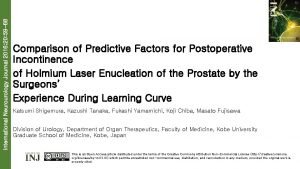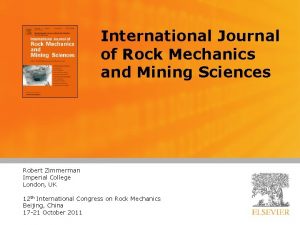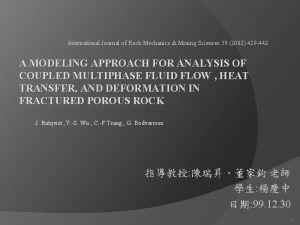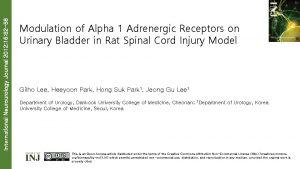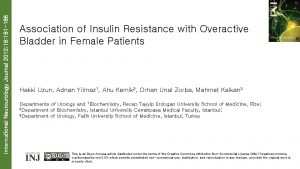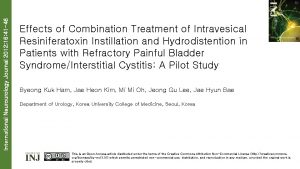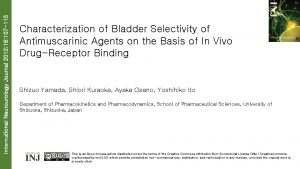International Neurourology Journal 2012 16 91 95 Shortterm






- Slides: 6

International Neurourology Journal 2012; 16: 91 -95 Short-term Effect of Radical Hysterectomy with or without Adjuvant Radiation Therapy on Urodynamic Parameters in Patients with Uterine Cervical Cancer Jin Kyu Oh, Min Soo Choo 1, Joongyub Lee 2, Noh-Hyun Park 3, Seung-June Oh 1 Department of Urology, Gachon University Gil Hospital, Incheon; 1 Department of Urology, Seoul National University Hospital, Seoul; 2 Medical Research Collaborating Center, Seoul National University Hospital, Seoul; 3 Department of Obstetrics and Gynecology, Seoul National University Hospital, Seoul, Korea This is an Open Access article distributed under the terms of the Creative Commons Attribution Non-Commercial License (http: //creativecommons. org/licenses/by-nc/3. 0/) which permits unrestricted non-commercial use, distribution, and reproduction in any medium, provided the original work is properly cited.

International Neurourology Journal 2012; 16: 91 -95 INTRODUCTION • Lower urinary tract dysfunction is the most common complication after radical pelvic surgery. The aims of this study were to assess the effect of radical hysterectomy (RH) on the storage function of the lower urinary tract and to evaluate the impact of radiation therapy (RT) on postoperative urodynamic parameters. MATERIALS AND METHODS • This was a retrospective review of preoperative and postoperative urodynamic variables, which were prospectively collected. All women from 2006 to 2008, who underwent RH for uterine cervical cancer with a stage of 1 A to 2 B with or without adjuvant RT were enrolled. All patients were divided into two groups: group 1, without RT, and group 2, with adjuvant RT. Urodynamic studies were performed before, 10 days after, and 6 months after RH.

International Neurourology Journal 2012; 16: 91 -95 RESULTS • A total of 42 patients with a mean (±standard error) age of 51. 9 (± 12. 3) years were analyzed. There were no significant differences in age, body mass index or clinical stage between the two groups. On the 10 th postoperative day, all parameters were decreased except postvoid residual volume. In comparison with group 2 (n=14), group 1 (n=28) showed a significant increase in bladder compliance. At 6 months postoperatively, bladder compliance in group 1 had increased four times or more compared with that on postoperative 10 days. However, it had increased only 2. 5 times in group 2 at the same time point (P<0. 001). CONCLUSIONS • The results of our study suggest that adjuvant RT after RH might result in a deterioration of bladder compliance. It is highly suggested that practitioners pay attention to low bladder compliance, especially in patients who have adjuvant RT after RH.

International Neurourology Journal 2012; 16: 91 -95 Table 1. Patients demographics in each group

International Neurourology Journal 2012; 16: 91 -95 Table 2. Changes in urodynamic parameters in total 42 patients

International Neurourology Journal 2012; 16: 91 -95 Table 3. Changes in urodynamic parameters in each group
